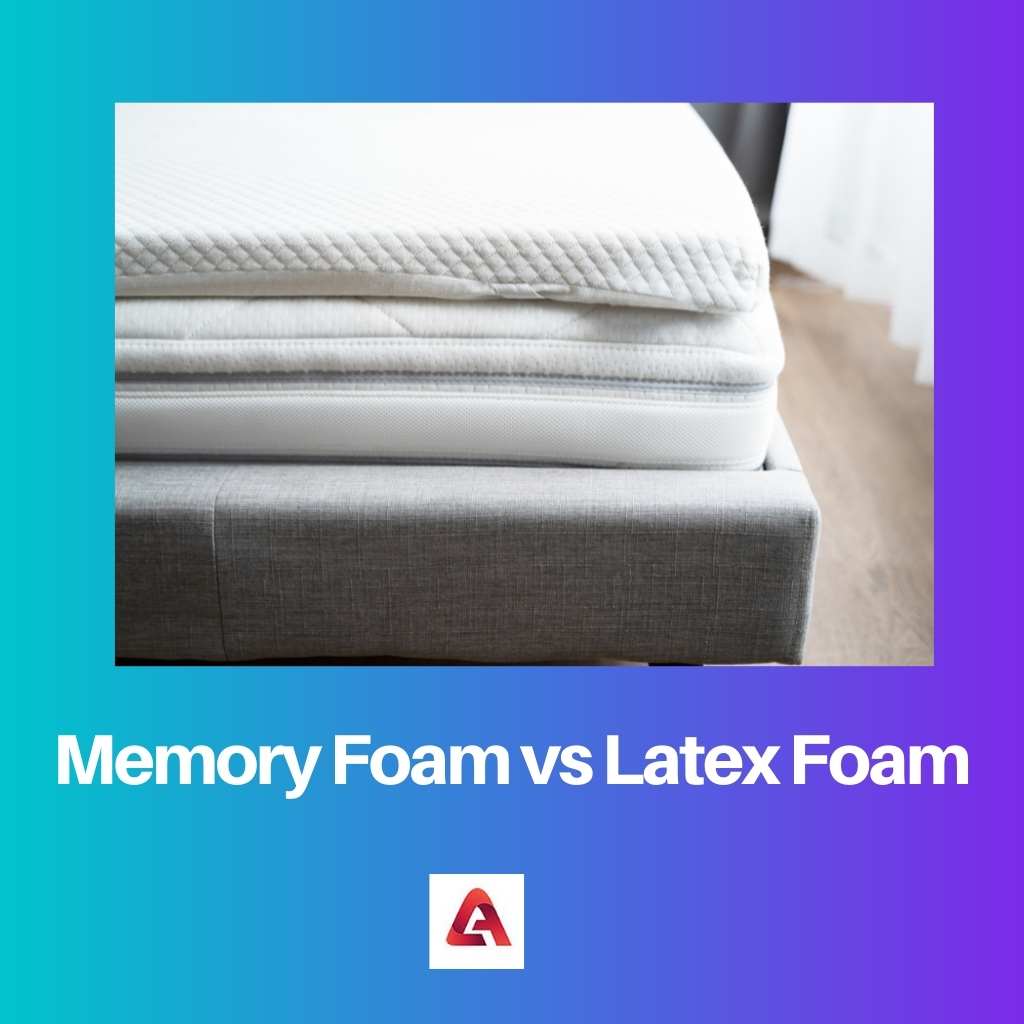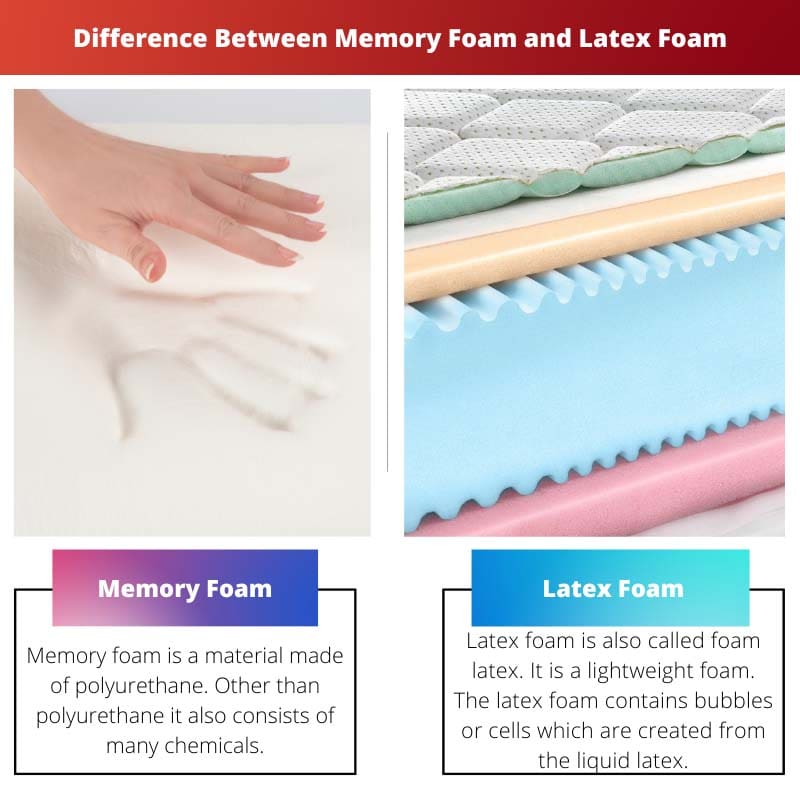Memory foam and Latex foam are two different kinds of foams. Both foam types have a wide range of applications. They are manufactured in different methods and used for distinct purposes.
They have different methods of manufacturing. But both the foams are produced worldwide.
Key Takeaways
- Memory foam is a viscoelastic material that conforms closely to the body and relieves pressure. In contrast, latex foam is a more resilient material derived from natural or synthetic rubber that offers support and responsiveness.
- Memory foam can retain heat and respond slower, whereas latex foam is more breathable and quickly regains its shape.
- Latex foam is considered more eco-friendly and durable than memory foam, but it may be less suitable for those with latex allergies.
Memory Foam vs Latex Foam
Memory foam is a type of viscoelastic foam that is known for its ability to conform to the shape of the body when pressure is applied. Latex foam is made from the sap of rubber trees and is known for its natural resilience and durability.It is known for its ability to provide excellent support and comfort.

Memory foam is a material made of polyurethane. Other than polyurethane it also consists of many chemicals. The primary purpose of the chemicals is to increase the viscosity and density of the foam.
The memory foam is also considered viscoelastic for its elastic property. Low resistance polyurethane is the other name of memory foam. The foam has bubbles or cells which are effectively move with the air.
The foam reacts to the body when it is high in density. The foams can easily be recovered to their original shape when it is new.
Latex foam is also called foam latex. It is a lightweight foam. The latex foam contains bubbles or cells which are created from the liquid latex. Dunlop or Talalay processes are used in the manufacturing of latex foam.
In this process, the liquid latex is molded and then the mattress is created. Using different kinds of polymers, the foam undergoes structural enhancements. The polymers act as fillers in the foams. Latex foams are known for their durability.
Comparison Table
| Parameters of comparison | Memory Foam | Latex Foam |
|---|---|---|
| Noisy | Less noisy | Noisier |
| Feel | Memory foam gives a cradling feel | Latex foam give on top feel |
| Temperature regulation | Memory foam is weak in temperature regulation | Latex foam has good temperature regulation methods. |
| Responsiveness | Slow response | Sudden response |
| Conformability | High | Less |
What is Memory Foam?
In memory foam, the network effect is responsible for the viscoelastic properties. The three effects are called pneumatic effect, adhesive effect, and relaxation effect.
The primary purpose of the network effect is to restore the original structure of the foam. Depending on the temperature, the nature of the foam gets changed. Mechanical properties of the foam may also play a vital role in the production of the mattress.
Every effect has separate purposes. The pneumatic effect structure the foam. The adhesive effect work against decompression. the relaxation effect work against expansion.
Glass transition temperature is responsible for the relaxation effect. The memory foam is temperature dependent and the glass transition temperature will be forcing the changes gradually.
If the temperature is too cold, then the foam becomes hard. If the memory foam is too hot, then it behaves like conventional foams. Polymeric creep explains the physics behind the memory foam.
The comfort of the mattresses produced from the memory foam will be affected by the mechanical properties of the foam. The comfort and durability will be split between trade-offs.
Several memory foams have rigid cells which cause lower weight and easy recovery of the original position.
The penetration of water can be prevented by a more dense or solid cell structure. These solid structures provide better durability and a great appearance.

What is Latex Foam?
Natural rubber latex is used in the production of latex foam in the early days. Nowadays for commercial purposes, an alternative of natural rubber latex called styrene-butadiene latex is used in manufacturing.
Mineral fillers are the major material used to enhance the stability properties. The mineral fillers also increase the load-bearing capacity and flame resistance.
Sometimes these fillers may break and cause weakness in tensile strength. The latex foam has various properties. Some of them are energy absorption, thermal conductivity, and compression.
Latex foam is known as a commercially suitable application for its various properties. The latex foam has some unique properties like soundproofing, transportation of goods, and upholstery.
Latex foam is widely used for the construction process. It is also used in the production of masks and facial prosthetics. Foams contain plastic which causes damage to the environment. So, more research is happening to make eco-friendly latex foams.
Latex foams are nothing but lightweight and expanded foams. The cellular air present inside the foams can create different shapes and sizes.
The amount of air present in the cells is responsible for the extension of the foam. Denser cells are called polyhedral, and less dense are spherical. Density is an important property of foam.
Main Differences Between Memory Foam and Latex Foam
- When compared to memory foam, Latex is more responsive.
- Memory foam is made of synthetic, whereas latex foam is made of natural rubber latex.
- Memory foam has a motion location technique, whereas latex foam does not have that technique.
- When compared to memory foam, latex foam does not work well in sound absorption.
- When compared to memory foam, latex foam are heavy and complex to move.

- https://www.researchgate.net/profile/Roslim-Ramli/publication/323143870_Novel_natural_rubber_latex_memory_foam/links/5a82aa5eaca272d6501a0820/Novel-natural-rubber-latex-memory-foam.pdf
- https://link.springer.com/article/10.1007/s10237-011-0345-8
